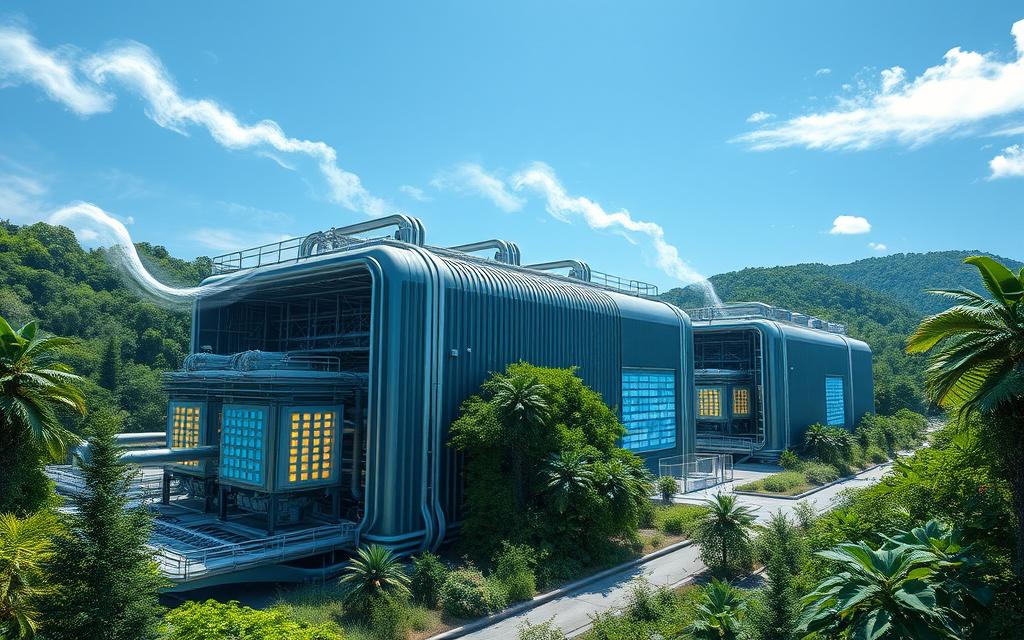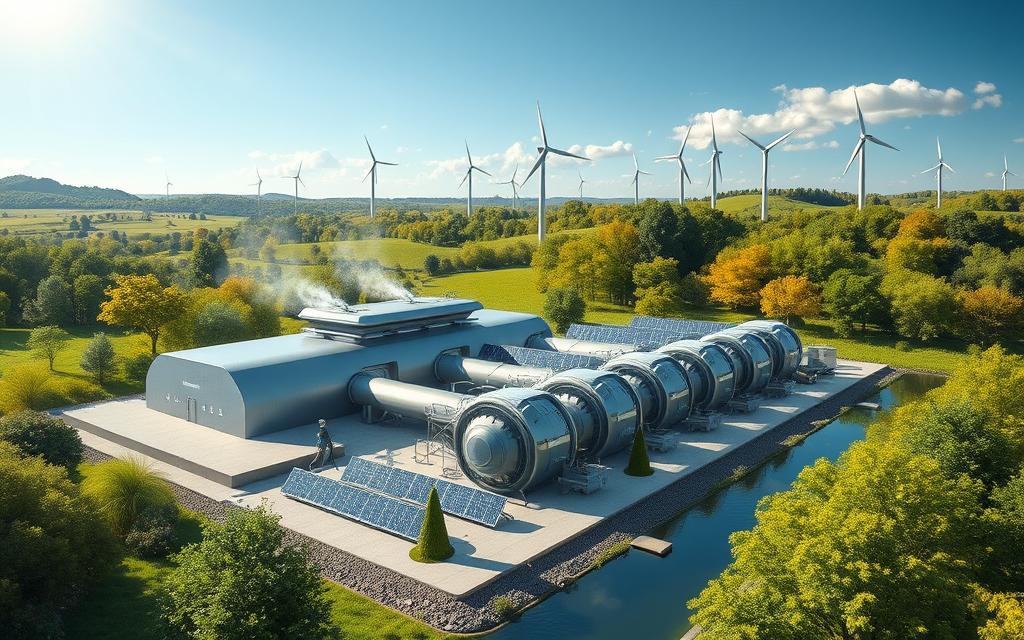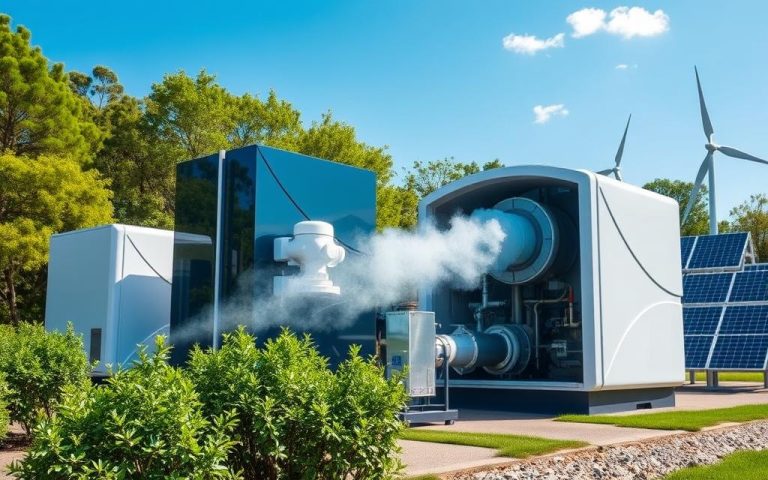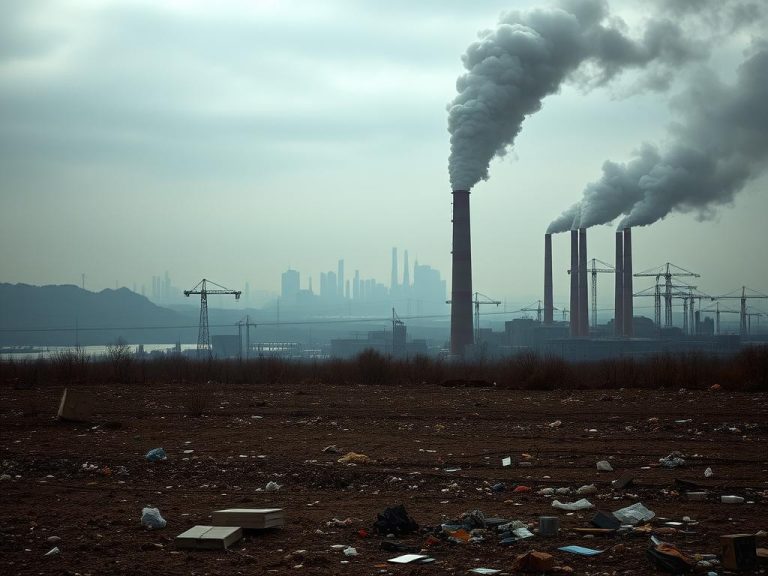Carbon Removal Technology: Cleaning the Air for a Greener Future
As we face climate change, the role of carbon removal technology is critical. The Paris Agreement in 2015 united 195 countries and the European Union. They agreed to keep the global temperature rise below 1.5 degrees Celsius. With CO2 levels at 420 parts per million, cutting down these emissions is crucial.
Direct Air Capture (DAC) is getting a lot of attention for a good reason. It has the potential to pull 5 to 40 gigatonnes of CO2 from the air yearly. But, we must remember, reaching net-zero by 2050 means cutting emissions everywhere.
By combining carbon removal methods with natural solutions, we boost our fight against climate change. Looking ahead, advancing research and new technologies is key. They will help us achieve a sustainable, cleaner world.
Introduction to Carbon Removal Technology
Carbon removal technology is key in fighting climate change by removing CO2 from the air. This introduction to carbon removal shows why it’s vital against high global CO2 levels. These levels are a big worry for climate goals in world agreements.
The Intergovernmental Panel on Climate Change (IPCC) tells us cutting emissions alone won’t meet climate targets. We need a mix of natural and tech methods for carbon removal. For example, planting more trees and Direct Air Capture (DAC) show the range of options we have.
The importance of carbon removal is huge. If we use these technologies well, we can make our environment sustainable. This means getting to net-zero emissions. Each carbon removal method has different steps, costs, and time needs. With emissions still going up, it’s crucial we start these solutions now.
By adding CDR to our climate strategies, we can tackle the problems we face. Knowing how these technologies work is crucial. This knowledge will help in making good policies and getting public support.
What is Carbon Removal Technology
Carbon removal technology involves a variety of methods to take carbon dioxide out of the atmosphere. It is crucial in the fight against climate change because it helps us reach net-zero emissions. With the urgent need for more action, industries like steel and cement are looking into these technologies more.
Definition and Importance
Developing ways to remove carbon helps lower greenhouse gases and lessen climate change effects. Techniques like direct air capture (DAC) and planting more trees are key to this. The IPCC highlights the need for these solutions to keep global warming below 1.5°C or 2°C. Big firms like Shopify and Google are investing in these to offset their emissions.
Historical Context of Carbon Removal
The history of carbon removal tech shows growing concern for climate problems and the search for answers. Early efforts have paved the way for breakthroughs. Now, companies like Climeworks are leading with projects that make these methods more common. They’ve moved from ideas to real ways to reduce carbon.
The Science Behind Carbon Removal Technologies
Carbon removal technologies are made to fight the climate crisis. This part talks about carbon removal mechanisms and how carbon removal works. It also looks at important technological advances that need to grow. The rise in global temperature by 1.35C since before the industrial times makes these solutions urgent.
Mechanisms of Action
There are many ways to remove carbon. For instance, direct air capture (DAC) involves pulling CO2 out of the air with big fans and filters. Nature-based methods, like planting more trees and improving soil to hold more carbon, use the natural world. Each has its advantages and issues, like how much energy they use, what they need to work, and how well they can capture and keep carbon dioxide.
Key Technologies Awaiting Scaled Deployment
New carbon removal technologies show great potential. Yet, they need more investment and development for widespread use. DAC and bioenergy with carbon capture and storage (BECCS) are leading the way. To move forward, they need to deal with big challenges like high operating costs and large energy needs. The demand to grow these solutions quickly is in line with Intergovernmental Panel on Climate Change (IPCC) advice.
The need to start using carbon dioxide removal technologies is very urgent. Research shows we need to take out up to 10 gigatonnes of CO2 every year by 2050 to hit climate goals. As per the IPCC report, just cutting down on emissions won’t do; adding strong carbon removal methods into climate plans is crucial. This is needed to fix our climate and avoid terrible outcomes. The effort’s success will depend on ongoing research, money, and new ideas.
| Technology | Description | Challenges | Potential |
|---|---|---|---|
| Direct Air Capture (DAC) | Extracts CO2 from ambient air using chemical processes. | High energy consumption, expensive infrastructure. | Scalability for significant carbon removal. |
| Bioenergy with Carbon Capture and Storage (BECCS) | Uses biomass to produce energy while capturing and storing emissions. | Land use competition, resource intensity. | Large potential for gigaton-scale removal. |
| Soil Carbon Sequestration | Increases soil carbon content through improved land management. | Effectiveness varies by practice, climate, and soil type. | Enhances soil health and agricultural productivity. |
The Role of Direct Air Capture (DAC) in Carbon Removal
Direct Air Capture (DAC) is key in battling climate change. It extracts CO₂ straight from the atmosphere using special tech. This involves big fans and chemicals that grab the CO₂. Once captured, the CO₂ is either reused or stored safely away. The direct air capture process differs from old methods that target specific sources, like factories.
How Direct Air Capture Works
A DAC system pulls in air and uses special materials to catch CO₂. This trapped CO₂ can then be stored deep underground or turned into things like fuel. For DAC to grow, it must solve some tough problems and become more efficient.
Challenges and Limitations of DAC
DAC tech faces big hurdles, especially in how much energy it uses. Because CO₂ in the air is spread out, catching it needs a lot of power, which can be costly. Choosing the right location is crucial too, as you need easy access to energy and storage spots. Experts think it might cost more than we thought, making it hard to use everywhere.
Current Developments in DAC Technologies
New progress in DAC is promising. Companies like Climeworks, Carbon Engineering, and 1 PointFive plan to build many plants by 2035. Also, laws giving tax credits for carbon removal help encourage people to invest. Efforts to improve DAC tech are ongoing, with Climeworks raising $650 million. With $3.5 billion in funding, the Direct Air Capture Hubs program aims to remove 1 million tons of CO₂ each year.

| Company | Planned Capacity by 2035 | Investment/Funding |
|---|---|---|
| Climeworks | High | $650 million (2022) |
| Carbon Engineering | Medium | Ongoing developments |
| 1 PointFive | Varied | Supported by public funding |
As DAC tech grows, it could create lots of jobs in building and making things. The aim is clear: overcome DAC’s limits and use it well to take CO₂ out of the air.
Nature-Based Solutions in Carbon Removal
Nature-based solutions help fight climate change by using natural processes. They focus on improving ecosystems to capture more carbon. This makes them key for a sustainable future.
Afforestation and Reforestation
Afforestation and reforestation are vital for removing carbon from the air. Afforestation not only captures carbon but also restores habitats and promotes biodiversity. Reforestation helps bring life back to used-to-be forests, helping the ecosystem store CO2 more efficiently. Both methods reduce atmospheric carbon by capturing it in trees through photosynthesis.
Soil Carbon Sequestration Techniques
Soil carbon sequestration uses farming methods to help soil hold more carbon. Techniques like cover cropping, less tillage, and using compost improve soil health and aid carbon capture. These methods also help farms resist climate change impacts. Healthier soils lead to better yields, supporting the fight against climate change.
| Technique | Primary Benefit | Impact on Carbon Sequestration |
|---|---|---|
| Afforestation | Creates new forests | Enhances CO2 absorption through tree growth |
| Reforestation | Restores degraded forests | Recaptures carbon and improves ecosystem health |
| Cover Cropping | Prevents soil erosion | Increases soil organic matter and CO2 storage |
| Reduced Tillage | Maintains soil structure | Enhances carbon retention in soil |
| Compost Application | Improves soil fertility | Promotes microbial activity and carbon stability |
The Economic Implications of Carbon Removal Technology
As climate change urgency increases, investment in carbon technologies has grown. Both companies and governments now see how crucial it is to fund carbon removal. This helps tackle environmental issues. Giants in the corporate world are investing in carbon capture, making sustainability a core part of their plans.
Investment Trends in Carbon Removal
The carbon dioxide removal market is growing fast. In the U.S., big tax incentives have boosted investment, raising demand for facilities. Companies like Stripe, Microsoft, and Shopify are investing heavily in making carbon removal permanent. This shows a big shift towards sustainable practices.
McKinsey’s report suggests the CDR industry could be worth around $1.2 trillion USD by 2050. This is because it could remove huge amounts of carbon, helping achieve net-zero targets. Already, 2,399 companies have pledged to reach net-zero by September 2023. This highlights the move towards being more green.
Costs Associated with Various Technologies
Investing in carbon technologies is rising, but the costs of carbon removal tech are still important. Different methods vary in price for capturing carbon. For example, DAC could cost between $125 to $335 per tonne of CO2, mostly because of its energy and infrastructure needs. On the other hand, nature-based solutions can be cheaper in some cases, offering businesses more ways to be sustainable.
The European Commission is working on a Carbon Removal Certification Framework. They want to set clear rules and standards for these technologies. This will help keep investments going while dealing with the economic challenges of carbon removal.
The Benefits and Drawbacks of Carbon Removal Strategies
Carbon removal strategies offer both environmental benefits and potential drawbacks. It is crucial to understand both the positive and the negative. This understanding involves looking at the advantages of carbon technology and its risks.
Environmental Benefits
Carbon removal brings down CO2 levels in the air, key for controlling climate. These methods also protect nature, keeping ecosystems stable and healthy. On top of that, they open up new economic paths. This means more jobs in fields like construction and engineering that help our planet.
Potential Risks and Trade-offs
Even with their benefits, the risks of carbon removal need careful thought. Many carbon removal methods use a lot of energy. This can take away resources from other important needs. The cost of these technologies is another big hurdle. A lot of money is needed for research, development, and setting everything up.
Using land for carbon removal can be good but also cause problems. It might harm local nature or affect water in bad ways. Plus, there’s worry about if the captured carbon stays put. If it leaks, it could undo any benefits.
With all these factors, it’s vital for people involved to think hard about how to use carbon technology wisely. They should consider both the good and the bad, and be ready for new challenges as these methods get better.
| Aspect | Benefits | Drawbacks |
|---|---|---|
| Job Creation | Boosts local economies and creates employment opportunities | Employment may be concentrated in specific regions |
| Costs | Development fosters economic growth | High initial investment and ongoing costs |
| Energy Usage | Potential for integration with renewable energy sources | Energy-intensive processes may increase carbon footprint |
| Land Use | Enhances biodiversity through ecosystem support | Can lead to land-use conflicts and negative ecological impacts |
| Permanence | Long-term solutions for carbon capture | Risks of carbon leakage or re-release into the atmosphere |
Conclusion
The future of carbon removal technology is key to reaching net-zero emissions and securing sustainable climate action. It combines innovative solutions and natural methods. However, we must tackle issues like scalability, cost, and ecological impact.
There is a big gap between current government efforts and the actual need for carbon dioxide removal. This highlights the need for more policy support and investments. Dr Steve Smith points out the importance of quick emission cuts to control global warming.
Even though over 120 nations aim for net-zero, actual plans for carbon dioxide removal are rare. This shows a real need for more funding and guidance. We must increase carbon removal tech by 2050 to achieve our climate targets.
To improve our planet, ongoing research and data are essential. As is the involvement of different groups in the carbon removal field. We need to overcome challenges and deploy solutions ethically to tackle global inequality. Our journey to sustainable climate action requires everyone’s commitment and careful planning.
FAQ
What is carbon removal technology?
A: Carbon removal technology is about taking CO2 out of the air to help stop climate change. It involves methods like using big machines to capture CO2 (DAC) and planting lots of trees (afforestation and reforestation).
Why is carbon removal important?
It’s key for fighting climate change by lowering CO2 in the air. To stop global warming, we need to remove a lot of CO2, especially from hard to change industries like steel and cement.
How does direct air capture (DAC) work?
DAC pulls CO2 from the air through big fans and chemicals. The captured CO2 can be reused or safely stored away.
What are the challenges associated with DAC?
DAC needs a lot of energy and money to work. It also has to be close to energy sources. Making DAC bigger brings questions about how well it will work and how much it will cost.
What are nature-based solutions for carbon removal?
These solutions use nature to capture CO2. They include growing forests and protecting soil to take in more CO2. They are good for nature and help grab CO2 from the air.
What are the economic implications of carbon removal technologies?
More companies are putting money into removing CO2 because it’s good for our planet. Some ways, like DAC, cost more than others. But investing in these technologies is important for our future.
What are the environmental benefits of carbon removal strategies?
These strategies reduce CO2, help wildlife, and keep the climate stable. They’re essential for a healthy planet.
What potential risks are involved with carbon removal technologies?
A: Risks include DAC’s big need for energy taking away from other needs. And, using land for capturing CO2 could cause conflicts over how the land is used.














